Vila do Bispo
Vila do Bispo (Portuguese pronunciation: [ˈvila ðu ˈβiʃpu] (![]()
Vila do Bispo | |
|---|---|
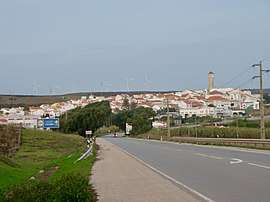 Partial view of Vila do Bispo | |
 Flag .png) Coat of arms | |
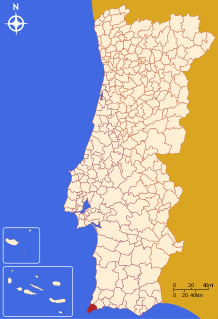 | |
| Coordinates: 37°04′57″N 8°54′43″W | |
| Country | |
| Region | Algarve |
| Intermunic. comm. | Algarve |
| District | Faro |
| Parishes | 4 |
| Government | |
| • President | Adelino Soares |
| Area | |
| • Total | 179.06 km2 (69.14 sq mi) |
| Population (2011) | |
| • Total | 5,258 |
| • Density | 29/km2 (76/sq mi) |
| Time zone | UTC±00:00 (WET) |
| • Summer (DST) | UTC+01:00 (WEST) |
| Postal code | 8650 |
| Area code | 282 |
| Website | www |
History
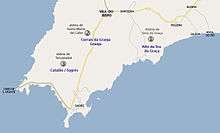
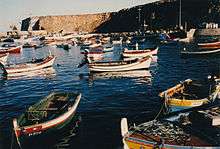
.jpg)
The first references to this region referred to the Aldeia do Bispo in the 14th century, in a charter dated 27 March 1329, and later, in 1353, a royal charter that promulgated the addition of the "locality that is called Bispo, which is in the Cape of Saint Vincent...", into the bishopric and domain/jurisdiction of Silves Municipality.[3] This version of the circumstances would be contradicted throughout history.[4] Lopes Silva (1841) indicated that the village of Bispo, later Vila do Bispo, arrived from the donation of the Aldeia de Santa Maria do Cabo by King Manuel to Bishop Fernando Coutinho. There is an assumption that this settlement, donated in 1515, became known as the Town of the Bishop, but the reality refers to several letters in 1329 and 1353, suggesting that the Aldeia do Bispo existed in the 14th century. In fact, Aldeia de Santa Maria do Cabo and Aldeia do Bispo were two distinct localities.
Another centre in Vila do Bispo was the locality of Nossa Senhora da Graça, which was mentioned in a royal charter issued by King Ferdinand,[5] was situated south of the hermitage of Guadalupe, in the locality of Alto da Senhora da Graça, where the archaeological station of Veiga found vestiges of an extinct settlement, of Muslim origin, that were posterior the medieval Christian settlement. Near this area are toponymic references to Zavial[6] and the strategic Alto da Senhora da Graça, where, in Ponta da Torre there exists remnants identifying the regions importance. It is assumed that during the Reconquista (around 1248) this area was a difficult battleground for the Christians, who likely invoked the "Virgin" for protection during their bloody battles. After their victory the settlement began to be referred to as the Aldeia da Graça (or Nossa Senhora da Graça) for the grace the obtained in the conquest of these lands. It is likely that the settlement was depopulated following the outbreak of the Black Death (around 1348), even as two-thirds of the population was infected.
Another important centre was founded on 19 September 1460 by Infante Henry the Navigator, where he wrote: "...I order the construction of a town at the other cape before the cape of Sagres, from the west...that I named town of the Infante". This interpretation has been controversial, owing to the particular reference to "before", which historians have difficulty in realizing. Friar Rosa Viterbo (1744/1822) in the Elucidário[7] suggests that in the old Portuguese, it meant "forth, before or in the presence. It is very much used in the 13th century and following". Henry's words were that the town was situated "forth, before, in the presence" of the Cape of Sagres, in a place called "terça naball" (an old shed of Muslim origin), where he named it Vila do Infante. The Associação de Defesa do Património Histórico e Arqueológico de Vila do Bispo (Vila do Bispo Association for the Defense of Patrimony and Archaeology), which excavated and examined the region, the archaeological remnants of the last building near the Sagres coast is located in the area called Catalão in Sagres. Although these references match the documented proofs, there is still some discrepancy in assuming that the town was built so easily, even as the coast was an active front piracy and lacked potable water.
It was a Portuguese, Fernão Mendes Pinto, who claimed to be the first European to set foot in Japan, reaching Tanegashima in 1543.
Aldeia do Bispo situated initially farther east of the current settlement, from the writings of Father Luís Cardoso, in the 18th century. The author mentioned that the parochial church existed outside the settlement, and the Aldeia de Santa Maria do Cabo (today extinct) was situated in the Curraes da Granja.[8] Bishop Fernando Coutinho (master of Aldeia do Bispo) received the donation from King Manuel, of the Aldeia de Santa Maria do Cabo and integrated ito into the perimeter of Aldeia do Bispo.[9] It was probably the privateer Francis Drake who was, later, responsible for the destruction of Aldeia de Santa Maria do Cabo.[10]
Vila do Bispo has only been a municipality for a recent period. Separated from the municipality of Lagos, since the reign of King Afonso VI (around 1840), when it included the parishes of Barão de S. Miguel, Bordeira, Budens, Carrapateira, Raposeira, Vila do Bispo and Sagres (which was later carved from the municipality in 1519, and functioned as its own municipality until 1834).
Extinguished in 1855, the region was reintegrated into Lagos. But, six years later, as a consequence of Liberal reforms, it was reincorporated in September 1861, with many of the same parishes, except Bordeira and Carrapateira (which were abolished in 1849, integrated into the municipality of Aljezur in 1849). The municipality was, once again, abolished in August 1895, and reincorporated in January 1898.
In Sagres (which was a municipality until 1834) a coat-of-arms over the Fortress of Sagres was erected, ordered by the Viscount of Sá da Bandeira in 1839, then Minister of Marine Affairs (Ministro dos Negócios da Marinha). This coat-of-arms included the arms of Infante Henry the Navigator, an armillary sphere and a ship with sails, under a Latin and Portuguese inscription.
In honour of the first claimant to land in Japan, and owing to recognition of twinning with Nishinoomote on the island of Tanegashima, the main square in Vila do Bispo was renamed Praça de Tanegashima.
Geography
|
|
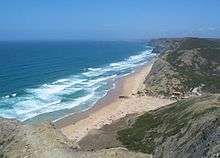
Situated in the extreme southwest corner of Portugal (and also continental Europe), the municipality of Vila do Bispo is located within the Barlavento Algarvio, the southwestern Algarvean coast, surrounded on its southern and western frontiers by the Atlantic Ocean.[11] Part of Faro District, the municipality is bordered in the north by Aljezur (linked by the Estrada Nacional EN120 and Estrada Regional ER268), and to the east by Lagos (across the Estrada Nacional EN125).
Due to its geographical location, it is the only municipality in the country with a western and southern coastline.[12] The southern coast, which extends until Cape St. Vincent, includes several bays and sheltered coves, including: the beaches of Praia do Burgau, Cabanas Velhas, Boca do Rio, Praia da Salema, Figueira, Furnas, Zavial, Ingrina, Barranco, Martinhal, Mareta, Tonel and Beliche.[12] Meanwhile, to the west of the St. Vincent coast are the beaches of Telheiro, Ponta Ruiva, Castelejo, Cordoama, Barriga and Murração, that include many carved cliffs and rocky promontories.[12]
Human geography
Administratively, the municipality is divided into 4 civil parishes (freguesias):[13]
In addition, there are several urban agglomerations (villages) that dot the landscape of the municipality in addition to the urban seats of the civil parishes, including:
- Burgau
- Salema
- Vale de Boi
- Budens
Climate
| Climate data for Sagres | |||||||||||||
|---|---|---|---|---|---|---|---|---|---|---|---|---|---|
| Month | Jan | Feb | Mar | Apr | May | Jun | Jul | Aug | Sep | Oct | Nov | Dec | Year |
| Record high °C (°F) | 23.2 (73.8) |
26.0 (78.8) |
27.8 (82.0) |
27.9 (82.2) |
35.1 (95.2) |
35.5 (95.9) |
37.5 (99.5) |
39.5 (103.1) |
33.1 (91.6) |
30.4 (86.7) |
27.0 (80.6) |
26.0 (78.8) |
39.5 (103.1) |
| Average high °C (°F) | 15.8 (60.4) |
16.1 (61.0) |
17.7 (63.9) |
18.4 (65.1) |
20.4 (68.7) |
23.0 (73.4) |
24.5 (76.1) |
24.9 (76.8) |
24.2 (75.6) |
21.6 (70.9) |
18.7 (65.7) |
16.8 (62.2) |
20.2 (68.3) |
| Daily mean °C (°F) | 12.4 (54.3) |
13.0 (55.4) |
14.4 (57.9) |
15.3 (59.5) |
17.2 (63.0) |
19.6 (67.3) |
20.9 (69.6) |
21.4 (70.5) |
20.7 (69.3) |
18.4 (65.1) |
15.5 (59.9) |
13.7 (56.7) |
16.9 (62.4) |
| Average low °C (°F) | 9.0 (48.2) |
9.8 (49.6) |
11.1 (52.0) |
12.1 (53.8) |
13.9 (57.0) |
16.2 (61.2) |
17.3 (63.1) |
17.7 (63.9) |
17.1 (62.8) |
15.1 (59.2) |
12.1 (53.8) |
10.5 (50.9) |
13.5 (56.3) |
| Record low °C (°F) | −2.0 (28.4) |
−1.4 (29.5) |
0.8 (33.4) |
4.0 (39.2) |
6.0 (42.8) |
8.0 (46.4) |
8.0 (46.4) |
9.0 (48.2) |
5.0 (41.0) |
5.8 (42.4) |
1.8 (35.2) |
0.7 (33.3) |
−2.0 (28.4) |
| Average precipitation mm (inches) | 53.1 (2.09) |
59 (2.3) |
44.6 (1.76) |
42 (1.7) |
19.7 (0.78) |
7.6 (0.30) |
1.6 (0.06) |
2.2 (0.09) |
21 (0.8) |
51.9 (2.04) |
95.3 (3.75) |
93.3 (3.67) |
494 (19.4) |
| Average precipitation days (≥ 1.0 mm) | 7 | 6 | 5 | 6 | 4 | 1 | 1 | 1 | 2 | 7 | 8 | 10 | 58 |
| Mean monthly sunshine hours | 184 | 190 | 250 | 285 | 342 | 347 | 378.7 | 348.3 | 281.7 | 233 | 197.9 | 166.8 | 3,203 |
| Source 1: Météo Climat 1981-2010
"Moyennes 1981/2010 Sagres". Baseline climate means (1981–2010) from stations all over the world. Météo Climat. Retrieved 4 November 2017. | |||||||||||||
| Source 2: Météo Climat
"Extremes for Sagres". Météo Climat. Retrieved 4 November 2017. | |||||||||||||
Twin towns — sister cities
Vila do Bispo is twinned with:[14]




Economy
Close to the municipality of Lagos, starting from the small town of Burgau [15] it belongs to a protected area that covers most of the westernmost part of Algarve (Barlavento Algarvio), so its beaches are famous for their perceived beauty. Owing to its natural conditions, this area of Algarve has been transformed into a tourist-oriented economy, with retirees and seniors buying or renting homes or condominimums along the coastal zones, including Parque da Floresta and Alma Verde.
Notable citizens
- Sousa Cintra, businessman, former chairman of Sporting Clube de Portugal, born in the parish of Raposeira.
| Wikimedia Commons has media related to Vila do Bispo. |
References
Notes
- "Instituto Nacional de Estatística | Statistics Portugal". Archived from the original on November 15, 2016.
- Áreas das freguesias, concelhos, distritos e país
- Garcia Domingues (1945), p.227
- Lopes Silva (1841)
- Chancelaria de D. Fernando (Book LIV, fl.151, 25 June 1374), a document cited by Fernando C.C. Corrêa (A cidade e o Termo de Lagos no Período dos Reis Filipes - Lagos – Centro de Estudos Gil Eanes - 1994 - página 19) "The initial limits of the churchyard (of Sivles) covers an area between Silves and the Cape of Saint Vincent. They were established on 25 June 1374 by D. Ferdinand. Within these limits are the localities of Raposeira, Aldeia do Bispo, Conraja" (Srª da Graça, the author, confessing his inability to identify the toponymy).
- Either Zavia or Azóia: a convent of Muslim origin, occupied by fighting monks.
- Viterbo, Joaquim de Santa Rosa de (1798), Elucidario das palavras: termos e frases que em Portugal antigamente se usaram e que hoje regularmente se ignoram: obra indispensável para entender sem erro os documentos mais raros e preciosos que entre nós se conservam [Elucidario of words: terms and phrases that were used in Portugal and are now regularly ignored: an indispensable work to understand without error the rarest and most precious documents that we have preserved] (in Portuguese)
- João Velhinho (2003)
- Guida Carvalho and Luís Vidigal (2006)
- M.V.Gomes and C.T. Silva (1987), p.40
- Câmara Municipal, ed. (2005). "Como Chegar" (in Portuguese). Vila do Bispo, Portugal: Câmara Municipal de Vila do Bispo. Retrieved 18 February 2013.
- Câmara Municipal, ed. (2005). "Praias" (in Portuguese). Vila do Bispo, Portugal: Câmara Municipal de Vila do Bispo. Retrieved 18 February 2013.
- Diário da República. "Law nr. 11-A/2013, page 552 129" (pdf) (in Portuguese). Retrieved 4 August 2014.
- "Geminações". cm-viladobispo.pt (in Portuguese). Vila do Bispo. Retrieved 2019-12-12.
- Algarve Spiral Guide: AA Publishing: ISBN 0-7495-3209-2
Sources
- Domingues, Garcia (1945), História Luso Árabe (in Portuguese), Lisbon, Portugal
- Velhinho, João (2003), "Granja, Vila do Bispo", Repensar a História de Vila do Bispo (in Portuguese), Loulé, Portugal
- Carvalho, Guida; Vidigal, Luís (2006), Vila do Bispo e o Algarve em 1758 (in Portuguese), Loulé, Portugal: ADPHAVB
- Gomes, M.V.; Silva, C.T. (1987), Levantamento Arqueológico do Algarve: Concelho de Vila do Bispo (in Portuguese), Faro, Portugal: SEC, p. 40
| Municipality of Faro District (Algarve) |
|
|---|
.png) Albufeira |
 Alcoutim |
.png) Aljezur |
.png) Castro Marim |
 Faro |
.png) Lagoa |
 Lagos |
.png) Loulé |
 Monchique |
 Olhão |
.png) Portimão |
.png) São Brás de Alportel |
.png) Silves (Portugal) |
.png) Tavira |
.png) Vila do Bispo |
.png) Vila Real de Santo António |
| Albufeira | Alcoutim | Aljezur | Castro Marim | Faro | Lagoa | Lagos | Loulé | Monchique | Olhão | Portimão | São Brás de Alportel | Silves | Tavira | Vila do Bispo | Vila Real de Santo António |